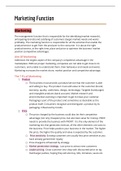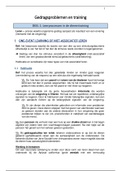Marketing
The management function that is responsible for the identifying (market research),
anticipating (trends) and satisfying of customers (target market) needs and wants
profitably. The marketing function is responsible for all the activities that enable the
product/service to get from the producer to the consumer. It is about the right
product/service, at the right time, place and price to optimise the business’ market
position (competitive advantage).
Aim Of Marketing
Addresses the largest aspect of the company’s competitive advantage in the
marketplace. Without proper marketing, companies are not able to get close to its
customers, and unable to understand them, their behaviour and needs and wants.
Marketing increases the market share, market position and competitive advantage.
The 7 P’s of Marketing
1. Product
○ The business must provide a product/service that the customer is able
and willing to buy. The product must add value to the customer (brand,
warranty, quality, usefulness, design, technology). Tangible (hamburger)
and intangible products (bank account). Market research and
environmental scanning is important to get to know your customer.
Packaging is part of the product and sometimes as desirable as the
product itself. Consumers recognize and distinguish a product by its
packaging. Influenced by trends.
2. Price
○ The price charged by the business could also be their competitive
advantage (not only cheapest price, but also best value for money). PRICE
needs to provide the business with PROFIT. It is the only element of the
marketing mix that generates revenue, all the other elements are costs to
the business. Price helps position your business in the market. The higher
the price, the higher the quality and value is expected by the customer.
○ Price sensitivity :Existing customers are usually less price sensitive as you
have already gained their loyalty
○ Price charged is influenced by strategy:
○ Market penetration strategy : Low price to attract new customers
○ Leader pricing : Draw customer into shop with discounted price on eg.
Hamburger patties, hoping they will also buy rolls, tomatoes, sauce etc.
, ○ Promotional pricing : Discounts offered close to special events eg. <
bubble bath for mothers day, > roses for Valentines day
○ Prestige pricing (luxury products) : Expectation to pay more eg.
Engagement ring (R500 or R5000 ?)
○ Types of goods:
➔ Consumer/Essential goods: Usually not very brand loyal, eg.
Bread/milk – speed and convenience of purchase
➔ Speciality goods: Consumers more careful and brand aware.
Marketing more target market focussed, eg. Cars.
➔ Select/Luxury goods: Customer will consider price, quality, brand
names eg. Clothing, jewellery
3. Place
○ This is where the customer will buy the product, this includes
convenience and effective distribution to this place. The product must be
available in the right place, time, quality and quantity while keeping
storage, transport and other costs to a minimum. Choosing the correct,
reliable supplier is crucial to this process and a competitive advantage.
(Franchising as a means of distribution gives the customer a sense of
quality and reassurance as a brand is known and trusted.)
○ Includes the way your products are displayed to your customer.
4. Promotion
○ This is the way a business communicates with the customer about what it
does and has to offer and includes: branding, advertising, PR, corporate
identity, personal sales, special offers, exhibitions etc.
○ Includes communication with all stakeholders and must be appealing.
○ Getting the correct level of attention from the target market (LSM).
5. People
○ All staff who come in contact with your customer will have an effect on
them and on their view and satisfaction of the business. The employee is
the face of the business. (Uniforms of staff creating/strengthening a
brand.)
○ Training and motivation is important as the brand and reputation of the
business rests in the hands of the staff.
6. Process
○ The process of providing the product/service is crucial to customer
satisfaction – eg. Waiting time, information given, helpfulness and that the
systems are working.
○ Consumer experience is important and will add to the competitive
advantage.



